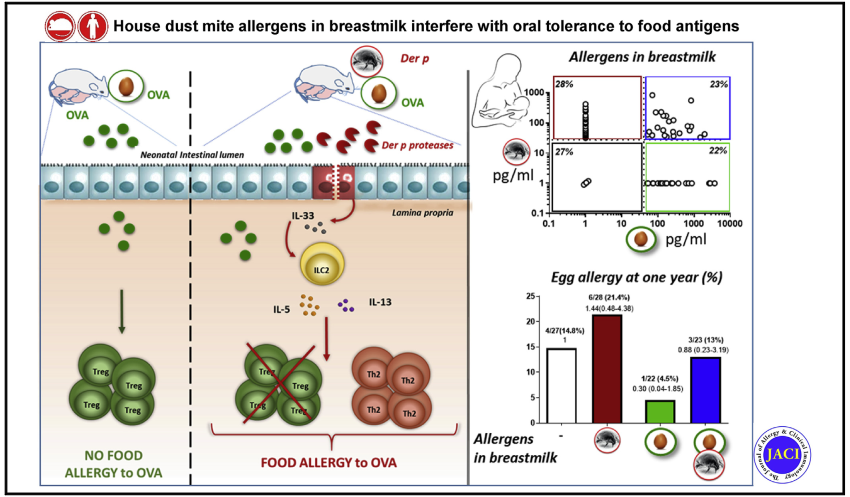JACI:早期经母乳接触屋尘螨过敏原在IgE介导的食物过敏易感性中的作用
发布日期:2020-10-23
原标题:早期经母乳接触屋尘螨过敏原在IgE介导的食物过敏易感性中的作用
方法:本研究研究了哺乳期暴露于屋尘螨过敏原(Der p)、蛋白酶灭活的屋尘螨过敏原或PBS的2周龄小鼠的肠道免疫功能。 同时进一步分析了对其他食物过敏原卵清蛋白(OVA)的口服耐受性。在一项概念验证研究中,测定了100份母乳样本中的Der p 1和OVA水平,并评估了与1周岁时IgE介导的鸡蛋过敏流行率的关系。
结果:与PBS相比,暴露于屋尘螨且母乳喂养的小鼠肠黏膜通透性、IL-33水平、2型固有淋巴细胞活化和TH2细胞分化均增加。这种TH2肠道粘膜环境抑制了抗原特异性FoxP3调节性T细胞的诱导和通过母乳中的OVA暴露预防食物过敏。而蛋白酶灭活的屋尘螨过敏原对后代肠道黏膜免疫无影响。基于人类母乳中存在Der p 1和/或OVA,我们确定了哺乳期母亲的群体,这与在小鼠身上发现导致不同鸡蛋过敏风险的因素一致。
结论:这项研究强调了一个不可预测的食物过敏的潜在危险因素,即母乳中的屋尘螨过敏原,它破坏肠道免疫稳态,并通过其蛋白酶活性抑制对其他食物抗原的口服耐受诱导。

延伸阅读
JACI
DOI: 10.1016/j.jaci.2019.12.912
Abstract:
Background: Successful prevention of food allergy requires the identification of the factors adversely affecting the capacity to develop oral tolerance to food antigen in early life.
Methods: Gut immunity was explored in 2-week-old mice breast-fed by mothers exposed to D pteronyssinus, protease-inactivated D pteronyssinus, or to PBS during lactation. We further analyzed oral tolerance to a bystander food allergen, ovalbumin (OVA). In a proof-of-concept study, Der p 1 and OVA levels were determined in 100 human breast milk samples and the association with prevalence of IgE-mediated egg allergy at 1 year was assessed.
Results: Increased permeability, IL-33 levels, type 2 innate lymphoid cell activation, and TH2 cell differentiation were found in gut mucosa of mice nursed by mothers exposed to D pteronyssinus compared with PBS. This pro-TH2 gut mucosal environment inhibited the induction of antigen-specific FoxP3 regulatory T cells and the prevention of food allergy by OVA exposure through breast milk. In contrast, protease-inactivated D pteronyssinus had no effect on offspring gut mucosal immunity. Based on the presence of Der p 1 and/or OVA in human breast milk, we identified groups of lactating mothers, which mirror the ones found in mice to be responsible for different egg allergy risk.
Conclusions: This study highlights an unpredicted potential risk factor for the development of food allergy, that is, D pteronyssinus allergens in breast milk, which disrupt gut immune homeostasis and prevents oral tolerance induction to bystander food antigen through their protease activity.
First Author:
Akila Rekima
Correspondence:
School of Molecular Sciences, University of Western Australia, M310, Perth WA 6009, Australia.
All Authors:
Akila Rekima, Chrystelle Bonnart, Patricia Macchiaverni, Jessica Metcalfe, Meri K. Tulic, Nicolas Halloin, Samah Rekima, Jon Genuneit, Samantha Zanelli, Samara Medeiros, Debra J. Palmer, Susan Prescott, Valerie Verhasselt
2020-09-14 Article
创建过敏性疾病的科研、科普知识交流平台,为过敏患者提供专业诊断、治疗、预防的共享平台。


——浙大迪迅 译
背景:要成功预防食物过敏,就必须找出影响早期口服食物抗原耐受能力的因素。方法:本研究研究了哺乳期暴露于屋尘螨过敏原(Der p)、蛋白酶灭活的屋尘螨过敏原或PBS的2周龄小鼠的肠道免疫功能。 同时进一步分析了对其他食物过敏原卵清蛋白(OVA)的口服耐受性。在一项概念验证研究中,测定了100份母乳样本中的Der p 1和OVA水平,并评估了与1周岁时IgE介导的鸡蛋过敏流行率的关系。
结果:与PBS相比,暴露于屋尘螨且母乳喂养的小鼠肠黏膜通透性、IL-33水平、2型固有淋巴细胞活化和TH2细胞分化均增加。这种TH2肠道粘膜环境抑制了抗原特异性FoxP3调节性T细胞的诱导和通过母乳中的OVA暴露预防食物过敏。而蛋白酶灭活的屋尘螨过敏原对后代肠道黏膜免疫无影响。基于人类母乳中存在Der p 1和/或OVA,我们确定了哺乳期母亲的群体,这与在小鼠身上发现导致不同鸡蛋过敏风险的因素一致。
结论:这项研究强调了一个不可预测的食物过敏的潜在危险因素,即母乳中的屋尘螨过敏原,它破坏肠道免疫稳态,并通过其蛋白酶活性抑制对其他食物抗原的口服耐受诱导。

延伸阅读
JACI
[IF:14.11]
A role for early oral exposure to house dust mite allergens through breast milk in IgE-mediated food allergy susceptibilityDOI: 10.1016/j.jaci.2019.12.912
Abstract:
Background: Successful prevention of food allergy requires the identification of the factors adversely affecting the capacity to develop oral tolerance to food antigen in early life.
Methods: Gut immunity was explored in 2-week-old mice breast-fed by mothers exposed to D pteronyssinus, protease-inactivated D pteronyssinus, or to PBS during lactation. We further analyzed oral tolerance to a bystander food allergen, ovalbumin (OVA). In a proof-of-concept study, Der p 1 and OVA levels were determined in 100 human breast milk samples and the association with prevalence of IgE-mediated egg allergy at 1 year was assessed.
Results: Increased permeability, IL-33 levels, type 2 innate lymphoid cell activation, and TH2 cell differentiation were found in gut mucosa of mice nursed by mothers exposed to D pteronyssinus compared with PBS. This pro-TH2 gut mucosal environment inhibited the induction of antigen-specific FoxP3 regulatory T cells and the prevention of food allergy by OVA exposure through breast milk. In contrast, protease-inactivated D pteronyssinus had no effect on offspring gut mucosal immunity. Based on the presence of Der p 1 and/or OVA in human breast milk, we identified groups of lactating mothers, which mirror the ones found in mice to be responsible for different egg allergy risk.
Conclusions: This study highlights an unpredicted potential risk factor for the development of food allergy, that is, D pteronyssinus allergens in breast milk, which disrupt gut immune homeostasis and prevents oral tolerance induction to bystander food antigen through their protease activity.
First Author:
Akila Rekima
Correspondence:
School of Molecular Sciences, University of Western Australia, M310, Perth WA 6009, Australia.
All Authors:
Akila Rekima, Chrystelle Bonnart, Patricia Macchiaverni, Jessica Metcalfe, Meri K. Tulic, Nicolas Halloin, Samah Rekima, Jon Genuneit, Samantha Zanelli, Samara Medeiros, Debra J. Palmer, Susan Prescott, Valerie Verhasselt
2020-09-14 Article
创建过敏性疾病的科研、科普知识交流平台,为过敏患者提供专业诊断、治疗、预防的共享平台。


 杭州浙大迪迅生物基因工程有限公司
杭州浙大迪迅生物基因工程有限公司

